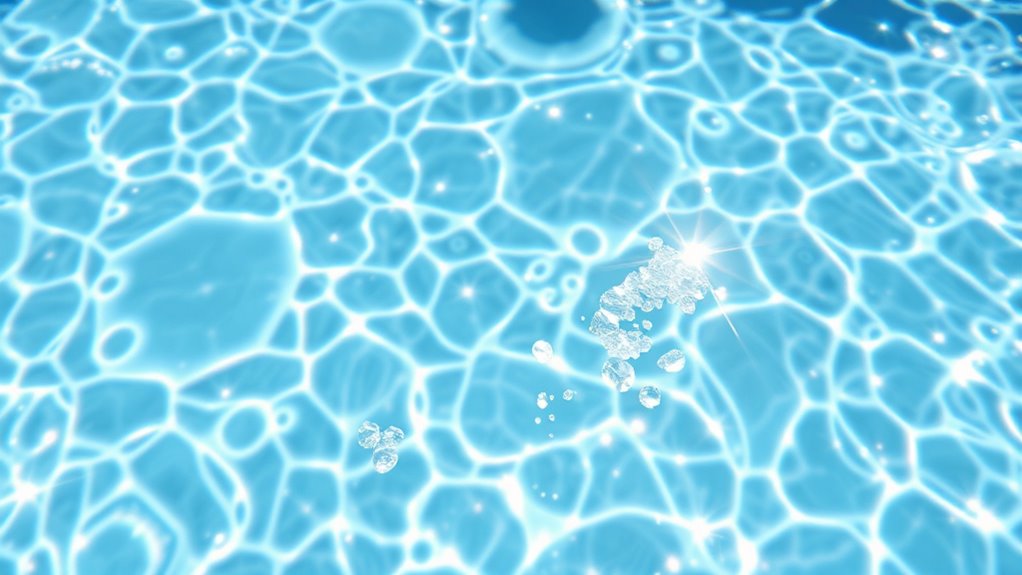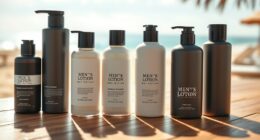High salt and chlorine levels in your water can hinder UV disinfection by reducing how deeply UV rays penetrate. They react with organic matter and create chlorinated byproducts like chloramines that absorb UV light, lowering its effectiveness. This means germs may survive longer, increasing health risks. Understanding how these chemicals impact UV exposure helps you better manage water quality; keep exploring to learn more about maintaining safe, clean water.
Key Takeaways
- High salts and chlorine levels can create uneven UV exposure zones, reducing disinfection effectiveness.
- Chlorine reactions produce chlorinated byproducts, like chloramines, that absorb UV light and hinder penetration.
- Elevated salt levels can alter pH and cause deposits, impairing UV’s ability to disinfect thoroughly.
- Imbalanced water chemistry diminishes UV penetration and increases health risks from surviving microbes.
- Regular monitoring and chemical adjustments help maintain optimal UV disinfection and reduce exposure risks.

While salts, chlorine, and UV rays are vital for maintaining clean and safe pools, they also pose health risks if not managed properly. When it comes to UV exposure, understanding how these elements interact is essential. UV penetration, the depth to which ultraviolet rays penetrate the water, can be affected by the presence of salts and chlorine. As UV rays pass through the water, they can break down contaminants and disinfect the pool, but their effectiveness depends on the water’s chemistry. If salts or chlorine concentrations are too high, they can alter how UV rays penetrate the water, sometimes reducing their ability to disinfect effectively or creating uneven exposure zones.
High salt and chlorine levels can reduce UV disinfection effectiveness and create uneven exposure zones.
Chemical interactions between salts, chlorine, and other pool chemicals also influence UV exposure risks. Chlorine, for example, reacts with organic matter and other compounds in the water, forming chlorinated byproducts. These reactions can produce disinfection byproducts like chloramines, which not only compromise water quality but also affect UV penetration. Chloramines tend to absorb UV light, decreasing the depth of UV penetration and reducing the overall disinfection efficiency. This means that even with UV treatment, if chloramines are present in high concentrations, UV rays won’t penetrate deeply enough to neutralize germs effectively, increasing the risk of microbial growth and health hazards.
Similarly, salts in the water can impact chemical interactions. Saltwater pools rely on electrolytic processes to generate chlorine, but the increased salt levels can influence how chlorine interacts with other substances. Elevated salt levels can lead to the formation of salt deposits and alter pH levels, which in turn affects how chlorine reacts within the water. When pH levels fluctuate, chlorine becomes less effective, and the UV’s ability to disinfect diminishes, since chlorine’s disinfectant properties depend on specific pH ranges. These chemical interactions can create a cycle where UV exposure becomes less efficient, requiring more chemical adjustments and increasing the potential for health risks. Additionally, vetted small wood stoves offer an eco-friendly alternative for heating outdoor spaces, reducing reliance on chemical disinfectants and UV treatments in some settings.
Managing these factors is key to maintaining a safe swimming environment. Regular testing of water chemistry helps monitor salt levels, chlorine concentrations, and pH. Adjusting chemical dosages appropriately ensures maximum UV penetration and minimizes the formation of harmful byproducts. By understanding how salts and chlorine influence UV penetration and chemical interactions, you can better prevent health risks, ensuring your pool remains both clean and safe for everyone.
Frequently Asked Questions
Do Salts and Chlorine Increase UV Radiation Absorption in the Skin?
Salt absorption and chlorine interaction don’t directly increase your skin’s UV radiation absorption. However, they can compromise your skin’s natural barrier, making it more vulnerable to UV damage. When salts or chlorine dry out or irritate your skin, it may become more sensitive to UV rays. So, while they don’t boost absorption, they can indirectly heighten your risk of sun damage by weakening your skin’s defenses.
How Do Salts and Chlorine Affect the Skin’s Natural UV Protection?
Imagine your skin as a shield protected by a delicate barrier. When salts absorption occurs, it’s like tiny grains eroding this shield, making it more vulnerable. Chlorine effects act as a corrosive agent, stripping away natural defenses. Together, salts and chlorine weaken your skin’s natural UV protection, increasing susceptibility to sun damage. You need to rinse thoroughly after swimming to restore your skin’s resilience and maintain its natural defense against harmful rays.
Can Salts and Chlorine Cause Skin Reactions When Exposed to UV Rays?
Yes, salts and chlorine can cause skin reactions when exposed to UV rays. If you’re salt-sensitive, you might experience irritation or increased sensitivity after exposure. Chlorine dermatitis, a skin condition caused by chlorine, can worsen with UV exposure, leading to redness, itching, or rash. These substances strip natural oils, weakening your skin’s barrier and making you more prone to reactions when exposed to sunlight. Always rinse thoroughly after swimming and protect your skin.
Are There Long-Term Skin Health Risks From Combined Salts, Chlorine, and UV Exposure?
Yes, combining salts, chlorine, and UV exposure can pose long-term skin health risks. You might notice increased skin aging signs like wrinkles and fine lines, caused by damage to your skin’s collagen. These elements can also disrupt your hydration balance, leading to dryness and irritation. To protect yourself, always rinse thoroughly after swimming, use broad-spectrum sunscreen, and stay hydrated to maintain healthy, youthful skin.
What Are the Best Protective Measures Against UV Risks in Salty or Chlorinated Environments?
To protect yourself from UV risks in salty or chlorinated environments, wear protective clothing like long sleeves, hats, and sunglasses to shield your skin and eyes. Apply broad-spectrum sunscreen generously, especially on exposed areas, and reapply it every two hours or after swimming. These measures help minimize UV damage, reduce skin health risks, and keep you safe while enjoying water activities.
Conclusion
Understanding how salts and chlorine impact UV exposure helps you stay safer in the sun. By recognizing the risks salts and chlorine pose, you can protect your skin, your eyes, and your health. Be mindful, be prepared, and take action to minimize harm. Because awareness is your best defense, because prevention is your best strategy, and because safety depends on your choices—stay informed, stay protected, and enjoy your time outdoors responsibly.









